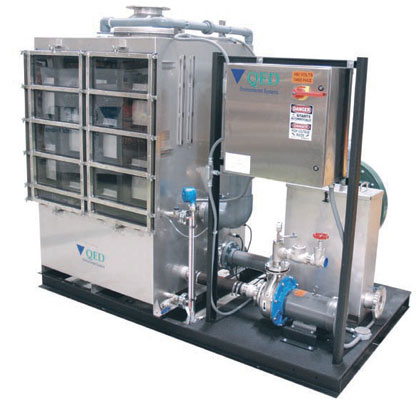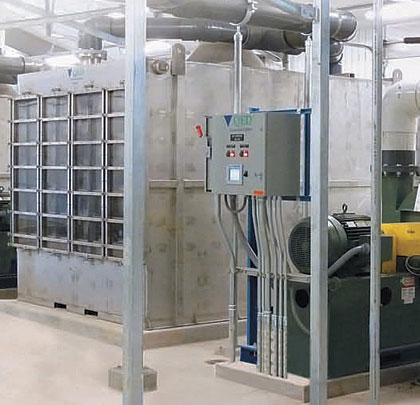Though drinking water tends to be relatively clean compared with water that is being considered for other uses, it sometimes can contain contaminants. Air stripping, a proven water treatment technology primarily used in the past for groundwater remediation in highly contaminated sites, is gaining traction within the drinking water treatment industry.
Air stripping has been proven to be highly effective for the removal of Volatile Organic Compounds (VOCs) and disinfectant byproducts (DBPs), as well as for pH adjustment through removal of dissolved CO2. It is gaining in popularity for the treatment of drinking water thanks to its efficiency, simplicity, and low cost per gallon in treatment, as well as its efficacy in helping to achieve finished water quality standards.
DRINKING WATER TREATMENT
Drinking water sources have been designated as such because they have been deemed clean enough for human consumption. Of course, this does not mean that these water sources are clean enough for consumption without treatment; indeed, strict standards are in place across the United States to ensure proper treatment of water before it reaches consumers. The most important treatment targets for drinking water are biohazards, and so drinking water must be disinfected. Other important concerns addressed by drinking water standards are the presence of volatile organic compounds (VOCs), disinfectant byproducts (DBPs) such as the carcinogenic trihalomethanes (THMs) left behind by the oxidation of organic materials during chlorine disinfection, and water pH. These concerns often result in violations of standards put forth by governmental regulations, particularly in small and medium-sized treatment plants.
Drinking water may come from either ground water or surface water sources, and each of these classes of water present their own challenges for treatment. In addition, a decade of near drought conditions in California and Texas have driven the implementation of water re-use approaches. Highly treated wastewater is now used to supplement and recharge some source waters for drinking use. If this water is used to recharge a groundwater source, it will have precursor organic levels closer to a surface water, leading to treatment needs that are somewhat of a hybrid of both types.
Groundwater tends to require less treatment than surface water; however, contamination (of VOCs in particular) from nearby sources like landfills or chemicals from manufacturing sites may leach through the ground into groundwater, thereby requiring increased treatment. Some groundwater may contain high levels of dissolved CO2, which causes increased acidity. This acidity can cause water to erode away protective coatings on pipes and increase copper and lead violations.
Surface water and reused water, on the other hand, are often more susceptible to precursor contamination like algae and other bio-solids. Like all drinking water, surface water and reused water require disinfection. Chlorination is the most common disinfection technique because it is inexpensive; however, chlorination can create potentially harmful DBPs that then require further treatment.
Air stripping, a water treatment technology proven to be effective for groundwater remediation in highly contaminated sites, is gaining traction within the drinking water treatment industry to address issues of VOCs, acidity due to dissolved CO2, and DBPs.
AIR STRIPPER TECHNOLOGY ALLEVIATES ISSUES
Fundamentally, air stripping removes or “strips” contaminants from water by contacting clean air with the contaminated water, causing the VOCs and other contaminants to move from the water into the air. There are three different major types of air strippers: towers, stacked trays, and sliding trays. Each of these have benefits and drawbacks, but all utilize the same basic mass transfer process of exposing contaminated water to clean air across high surface areas. This process is governed by Henry’s Law. The Henry’s Law constant (H) of any dissolved contaminant can be used to predict how effectively that contaminant will be driven from the water into the air. Some contaminants are of course easier to strip than others; for instance, dissolved gases such as methane and carbon dioxide strip easily, light hydrocarbons less so, and MTBE and ammonia are relatively difficult to strip.
Of the three different types of air strippers, sliding tray design strippers tend to have the greatest advantages and lowest costs. They are less prone to fouling, less intrusive at the site, provide a wider flow turn-down than tower strippers, and provide easier maintenance access and a smaller footprint than either towers or stacking tray designs. The main drawback is that they require a higher pressure blower than tower designs; however, this does not significantly add to the overall cost of operation when factors such as maintenance and materials are also considered.
A LOOK AHEAD
All types of air strippers can be used for drinking water decontamination. The most clear-cut application in drinking water is in the removal of VOCs, including the THMs that are byproducts of chlorine disinfection. In next month’s installment, we’ll take a closer look at air strippers like QED’s E-Z Tray units in action.
About the Author:
Dave Fischer is vice president of technology and product manager for treatment equipment for QED Environmental Systems, Inc. QED Environmental Systems is the leading manufacturer of innovative environmental products. For over thirty years their expertise has included pumping systems, landfill products, and air strippers. For more information, visit www.qedenv.com.
_______________________________________________________
MODERN PUMPING TODAY, April 2018
Did you enjoy this article?
Subscribe to the FREE Digital Edition of Modern Pumping Today Magazine!
![]()




